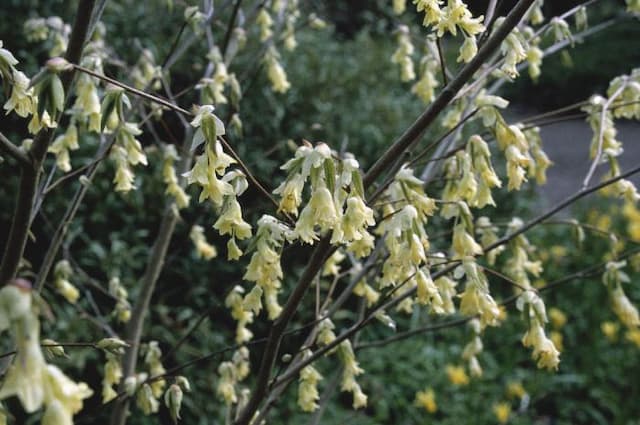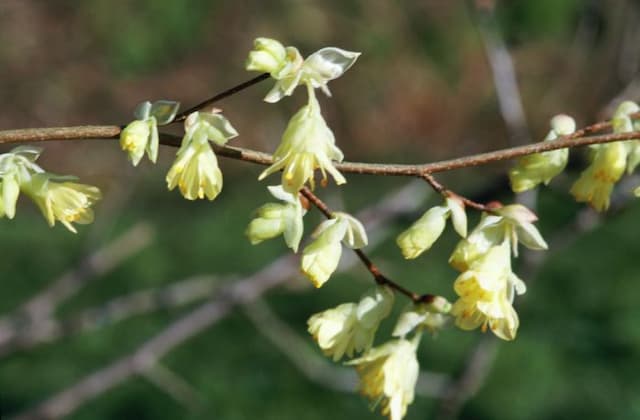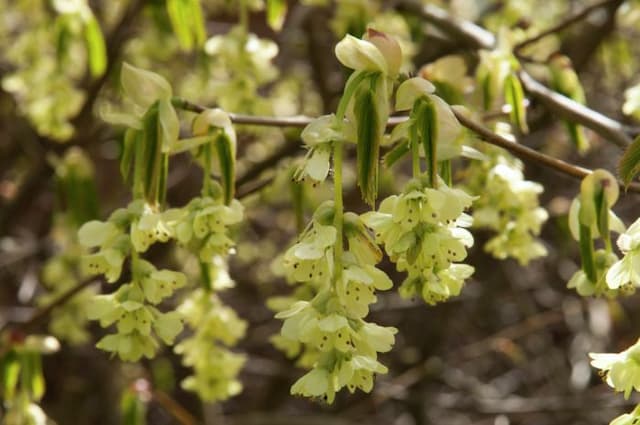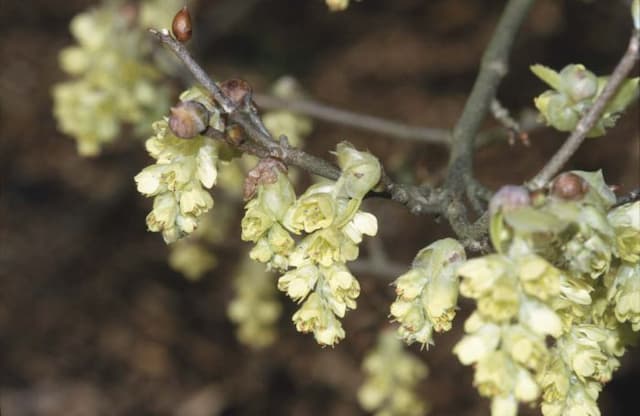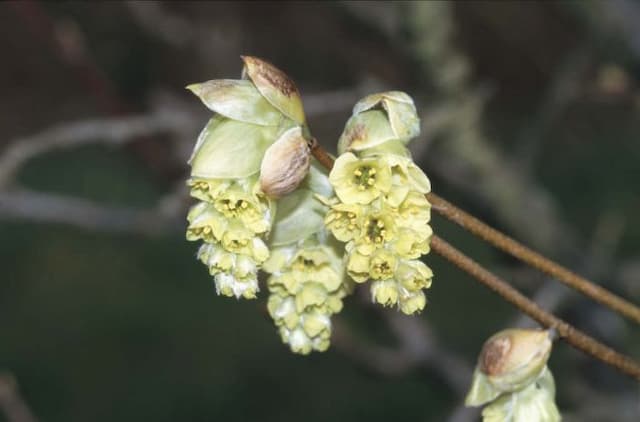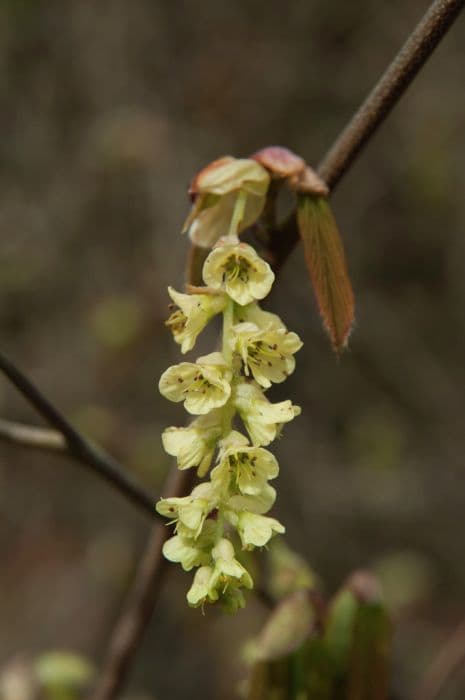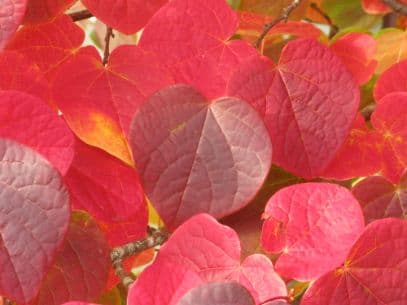Witch Hazel Hamamelis × intermedia 'Orange Beauty'

ABOUT
The 'Orange Beauty' Witch Hazel is an ornamental shrub known for its unique and attractive flowers. This plant boasts vibrant, orange-colored, ribbon-like petals that emerge in the late winter to early spring, often when few other plants are in bloom. The flowers have a spicy fragrance and are striking against the bare branches, creating a cheerful display during the duller months. The foliage of 'Orange Beauty' is also noteworthy, with leaves that are broad and oval-shaped, offering a pleasing green backdrop through the growing season. In the fall, the leaves transform into an array of colors, turning shades of yellow, orange, and red before dropping.
About this plant
 Names
NamesFamily
Hamamelidaceae
Synonyms
Witch Hazel, Hybrid Witch Hazel, Orange Beauty Witch Hazel
Common names
Hamamelis × intermedia 'Orange Beauty'.
 Toxicity
ToxicityTo humans
Witch hazel, specifically the 'Orange Beauty' cultivar, is not commonly known to be toxic to humans. There is little information suggesting that this plant poses significant risks when touched or ingested in small quantities. However, consuming any plant not meant for ingestion could potentially cause mild stomach upset or an allergic reaction in sensitive individuals. As with any plant, it is advisable to avoid ingesting it unless it is known to be safe for consumption.
To pets
Witch hazel is also not widely recognized as being toxic to pets. There are no well-documented cases of poisoning in pets from consuming witch hazel. However, as with humans, ingestion of non-food plants by pets can sometimes result in gastrointestinal upset or an allergic reaction. It is generally best to prevent pets from eating ornamental plants to avoid any potential issues.
 Characteristics
CharacteristicsLife cycle
Perennials
Foliage type
Deciduous
Color of leaves
Green
Flower color
Orange
Height
10-15 feet (3-4.5 meters)
Spread
10-15 feet (3-4.5 meters)
Plant type
Shrub
Hardiness zones
5-8
Native area
Japan China
Benefits
 General Benefits
General Benefits- Attractive Flowers: Witch Hazel 'Orange Beauty' produces vibrant orange flowers that add a splash of color to the winter garden when few other plants are in bloom.
- Winter Interest: With its late-winter flowering, Witch Hazel 'Orange Beauty' provides visual interest during a time of year when gardens can be quite barren.
- Fragrance: The flowers emit a delightful fragrance, which can be a pleasant addition to a garden or landscape setting.
- Wildlife Habitat: Witch Hazel can provide shelter and food for birds and other wildlife during the winter months.
- Seasonal Foliage: The plant offers attractive foliage that changes color with the seasons, adding variety and appeal to the garden.
- Low Maintenance: Witch Hazel 'Orange Beauty' is known for being hardy and relatively low maintenance, requiring minimal care once established.
- Drought Tolerance: Once established, Witch Hazel 'Orange Beauty' is quite tolerant of drought, reducing the need for frequent watering.
- Adaptability: This plant can adapt to a range of soil conditions, making it a versatile choice for different garden situations.
- Architectural Interest: With its unique growth habit and structure, Witch Hazel 'Orange Beauty' can serve as a focal point or specimen plant in landscape design.
 Medical Properties
Medical PropertiesThis plant is not used for medical purposes.
 Air-purifying Qualities
Air-purifying QualitiesThis plant is not specifically known for air purifying qualities.
 Other Uses
Other Uses- Witch Hazel 'Orange Beauty' branches can be used as natural fencing or trellises in the garden, providing structural support for climbing plants and adding a unique aesthetic.
- The plant's colorful foliage and flowers can be used in floral arrangements, particularly in autumn and winter when colors are scarce in the garden.
- Dried Witch Hazel 'Orange Beauty' leaves can create a fragrant potpourri mix to freshen up indoor spaces during the cold season.
- The dense shrub can be planted to reduce noise pollution, acting as a buffer that absorbs sound in urban gardens.
- Because of its dense structure, Witch Hazel 'Orange Beauty' can be used for privacy screening, creating secluded areas in the garden.
- Artists can use Witch Hazel 'Orange Beauty' as a natural source of dye for fabrics and paper, potentially offering hues of yellow to brown depending on the mordant used.
- Witch Hazel 'Orange Beauty' wood can be utilized for small woodworking projects like crafting utensils or decorative objects due to its strength and fine grain.
- In winter, the frost-resistant branching patterns provide visual interest in the garden, where they can be highlighted with landscape lighting.
- Leather crafting can benefit from tannins found in the bark of Witch Hazel 'Orange Beauty', transferring its properties during the tanning process.
- Photographers and painters often use the striking appearance of Witch Hazel 'Orange Beauty' as a subject for their work, capturing the beauty of the flowers against the bare winter landscape.
Interesting Facts
 Feng Shui
Feng ShuiThe Witch Hazel is not used in Feng Shui practice.
 Zodiac Sign Compitability
Zodiac Sign CompitabilityThe Witch Hazel is not used in astrology practice.
 Plant Symbolism
Plant Symbolism- Fascination: The Hamamelis, commonly known as Witch Hazel, often blooms during late winter, showcasing its resilience and unique beauty. This can symbolize a sense of fascination with the natural world and its surprising moments.
- Protection: Witch Hazel was traditionally used by Native Americans for medicinal purposes, and it's still used today as an astringent and in skincare. This presents it as a symbol of care and protection.
- Healing: With its therapeutic properties, Witch Hazel symbolizes healing, both physical and emotional, as it can be used to treat wounds and skin conditions.
- New Beginnings: Blooming in the quiet of winter, Witch Hazel represents new beginnings or hope in the face of adversity, a reminder that even in the coldest times, life finds a way to flourish.
- Unique Charm: The 'Orange Beauty' cultivar specifically, with its bright orange flowers, is a symbol of uniqueness and charm, standing out from the typical winter landscape.
 Water
WaterThe Witch Hazel 'Orange Beauty' should be watered deeply and thoroughly, ensuring that the soil is moist but not waterlogged. Water the plant once every 7 to 10 days, providing about 1 to 1.5 gallons of water each time for medium-sized shrubs. During hot or dry periods, increase the frequency of watering to prevent the soil from drying out completely. It is essential to reduce watering in the winter months when the plant is dormant, and the soil retains moisture longer. Always check the soil moisture before watering to avoid overwatering, as this can lead to root rot.
 Light
LightWitch Hazel 'Orange Beauty' thrives best in full sun to partial shade. The ideal spot offers morning sunlight with some afternoon shade to protect it from the intense heat of the day. Providing dappled sunlight throughout the day is also beneficial, as this simulates the natural environment where these plants often grow under the canopy of larger trees.
 Temperature
TemperatureWitch Hazel 'Orange Beauty' is quite hardy and can tolerate temperatures as low as 0 degrees Fahrenheit, although growth may be affected if temperatures consistently fall below this range. It can also withstand summer temperatures up to 85 degrees Fahrenheit without issue. Ideally, this plant prefers a temperate climate with seasonal changes, and it performs well in the typical temperature range between 30 and 75 degrees Fahrenheit.
 Pruning
PruningPrune Witch Hazel 'Orange Beauty' immediately after flowering in late winter or early spring to maintain an attractive shape and remove any damaged or crossed branches. Pruning is essential not only for aesthetic reasons but also to promote healthy growth and enhance flowering for the following season. Annually assessing the shrub and removing a few of the oldest stems can rejuvenate the plant over time.
 Cleaning
CleaningAs needed
 Soil
SoilWitch Hazel 'Orange Beauty' thrives in acidic to neutral soil, pH 5.5 to 6.5, with a mix rich in organic matter. Use a blend of two parts loamy soil, one part sand or perlite, and one part peat or compost to ensure good drainage and soil fertility.
 Repotting
RepottingWitch Hazel 'Orange Beauty' is typically a large shrub and not commonly repotted. Plant it in the ground or a large container where it won't need frequent repotting.
 Humidity & Misting
Humidity & MistingWitch Hazel 'Orange Beauty' tolerates a wide range of humidity levels, although it prefers average to high humidity, avoiding excessively dry conditions.
 Suitable locations
Suitable locationsIndoor
Witch Hazel 'Orange Beauty' rarely grown indoors; needs ample space, bright light.
Outdoor
Plant in well-draining soil, partial to full sun, protect from harsh winds.
Hardiness zone
5-8 USDA.
 Life cycle
Life cycleThe life of the Witch Hazel 'Orange Beauty' begins with seed germination, usually in late spring to early summer, as soil temperatures warm. The germinated seedlings grow into juvenile plants, developing a woody stem and branching structure over the first few years. As a young adult plant, it enters its reproductive phase, typically flowering in late winter to early spring with fragrant orange to red flowers before the leaves emerge. This period is followed by leaf-out in the spring when the plant exhibits new green foliage. Throughout the summer, the leaves mature and the plant focuses on photosynthesis and growth. Finally, after several years, it reaches maturity and continues to cycle through seasons of flowering and vegetative growth, with seed production occurring each year, spreading to propagate new plants.
 Propogation
PropogationPropogation time
Late Winter to Early Spring
The common name for Hamamelis × intermedia 'Orange Beauty' is Hybrid Witch Hazel, and the most popular method for propagating this plant is through softwood cuttings. Best taken in late spring to early summer, when new growth is still flexible but mature enough to withstand handling, you should select healthy, non-flowering shoots. Cut a piece about 4 to 6 inches (10 to 15 centimeters) long, making the cut just below a leaf node. Remove the lower leaves, dip the cutting in rooting hormone to enhance root development, then plant the cutting in a soilless potting mix. Ensure the environment is humid and maintain consistent moisture without over-watering. Roots typically develop within 4-6 weeks, after which the young plants can be hardened off gradually and eventually transplanted outdoors.
